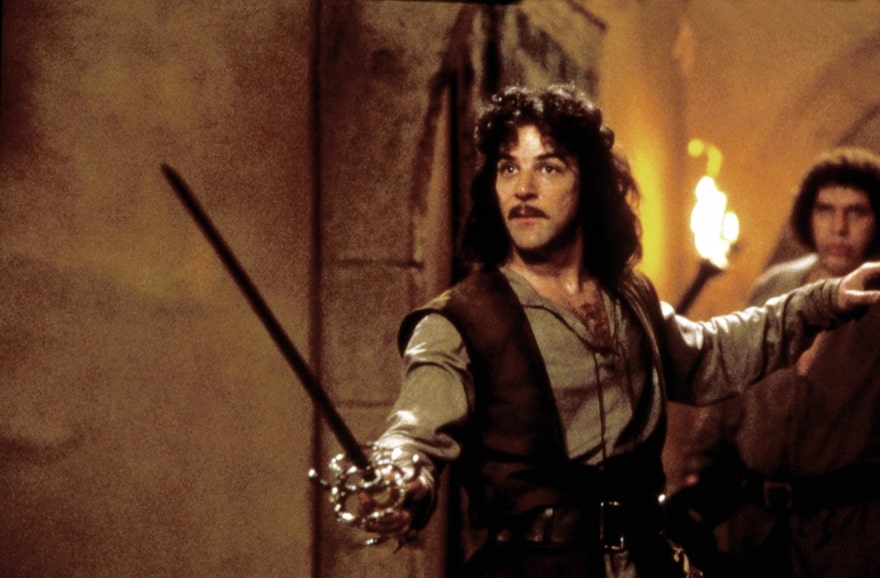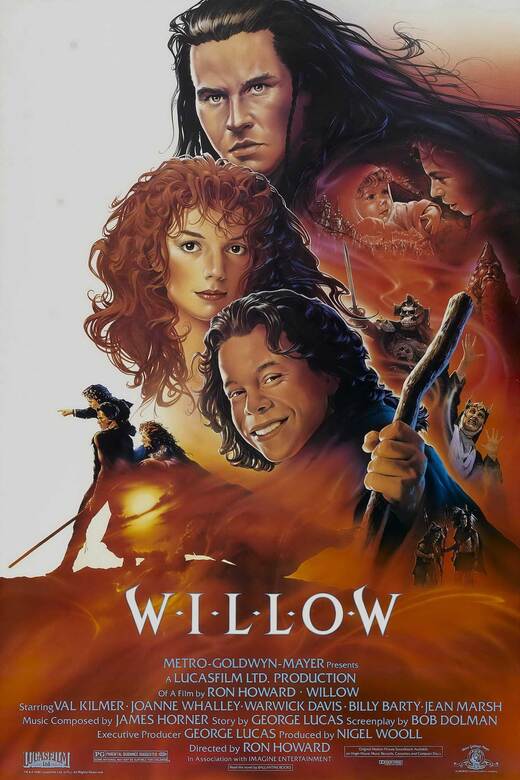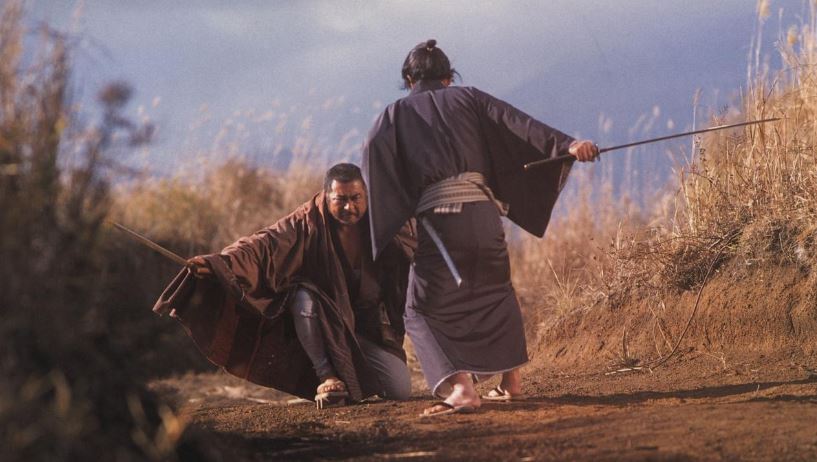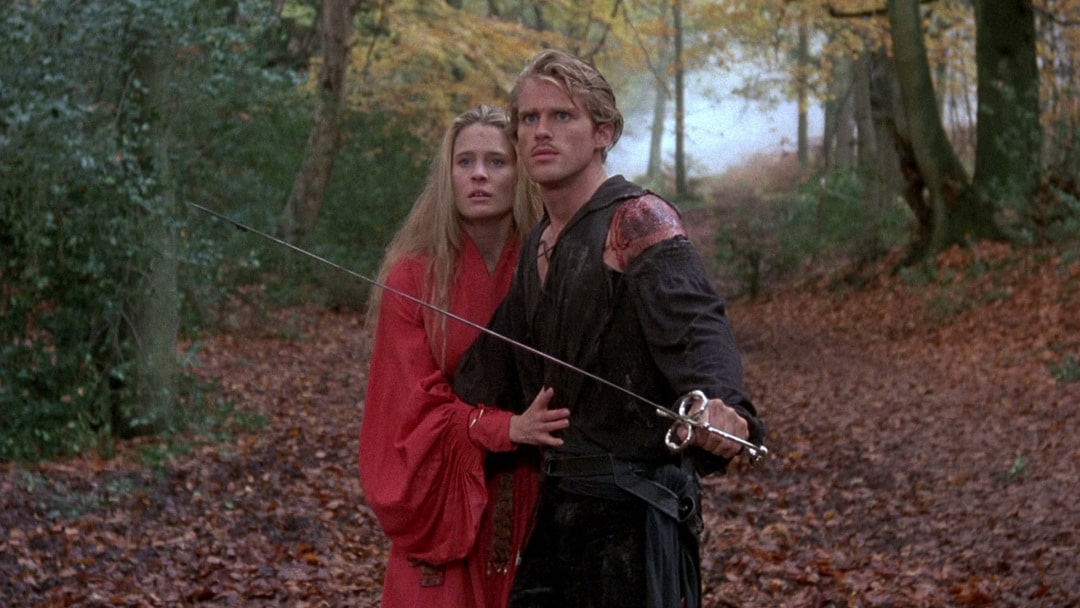Ellsworth’s Cinema of Swords: The Princess Bride Redeems the ‘80s
The Princess Bride (USA, 1987)
George Lucas and Stephen Spielberg: we may love their movies, but those guys have a lot to answer for. Their early fantasy action blockbusters, especially the Star Wars series, were such global mega-hits that they spawned countless imitators making noisy, busy, and sadly shallow films that flooded the theaters from the late ‘70s throughout the ‘80s. Everyone was chasing the golden youth market that was supposedly hooked on broad, colorful action enhanced by flashy special effects — and this pursuit infected not just Hollywood, but European and Asian studios as well.
There were some worthwhile films that followed that formula, of course — Excalibur, Time Bandits, Highlander — but in general, we got an endless series of loud actioners bloated by chase scenes, slo-mo heroic leaps, and large explosions (so many explosions). But then, in 1987, along came The Princess Bride, a small miracle of a movie with brains, heart, courage, sly wit and sharp dialogue, a film that made it possible to forget all about Red Sonja. And suddenly, the ‘80s didn’t look so bad after all.
Willow
Rating: **
Origin: USA, 1988
Director: Ron Howard
Source: 20th Century Fox DVD
J.R.R. Tolkien first found mass popularity in the late Sixties, and by the early Seventies The Lord of the Rings was everywhere. Legions of readers devoured the trilogy and its prequel The Hobbit and then looked for more of the same — but there was no more, so certain fantasy novelists undertook to give those readers what they wanted by engaging in the sincerest form of flattery. Tolkienesque fantasy epics rolled out by twos, threes, and then dozens, thick paperbacks with colorful covers atop stories about humble but plucky heroes determined to save their imaginary worlds from dire, dark tyrants. Typically, these novels employed emulation more than originality, adding little to what they knew would be popular. With the same plot and character elements recycled over and over, these books came to be known as generic fantasies.
Derivative in every way, with scarcely an original idea to be found in its entire 126 minutes, Willow is a textbook generic fantasy. Its story, written by George Lucas and scripted by Bob Dolman, seems calculated to deliver everything an ardent Tolkien fan could desire. Like Hobbits? Willow has short folk called Nelwyns who live in peaceful farming villages. Like Gandalf? Willow has not one, but two charming and elderly good wizards, one male, one female. Like Galadriel? Willow has a prophetic and magical forest queen named Cherlindrea who even glows in the dark. Like Strider? Willow has a scruffy warrior hero who looks ill but means well. Like Frodo and Bilbo? Willow has a spunky but persistent half-sized hero named, well, Willow.
A Lucasfilm picture, this is a luxe production, no expense spared, with fantastic and evocative sets, warriors in exquisite fantasy armor, exteriors shot in exotic locations, and excellent-for-the-time special effects by Industrial Light and Magic. Lucas got Ron Howard to direct, the always reliable James Horner to compose the soundtrack, and Bill Hobbs, the best fight director of his generation, to choreograph the swordplay.
And yet, despite all that and the best of intentions, this movie is a stone drag. Other than Val Kilmer, who plays the Strider-ish character Madmartigan with surprising enthusiasm, the leads are dull, unappealing, and unmemorable, including Warwick Davis as Willow, who is supposed to be funny and appealing but mostly just comes across as irritable and petulant.
The story is so predictable — in fact, its predictability is the point — that it’s hard to stay interested as it unrolls in tepid inevitability, and there’s little urgency to the plot because the pacing just plods. Gratuitous action scenes like Indiana Jones-style headlong vehicle fights and downhill snow-sled escapes add nothing, even when Chuck Jones antics are added to Indiana Jones, because you know exactly how they’ll end. And that dead-on-arrival romance between Madmartigan and Sorsha (Joanne Whalley), the evil tyrant’s vapid daughter? Don’t even start with me.
And then there’s the brownies, two prancing four-inch loons with Monty Python French accents who are threatened, over and over, with being crushed flat by the battles going on over their heads, and yet somehow, no matter how much and how hard you want it, they are never crushed flat. The brownies. Ancient gods, preserve us.
Zatoichi: Darkness is His Ally
Rating: ***
Origin: Japan, 1989
Director: Shintaro Katsu
Source: Arrow Films DVD
After starring in 25 films and four TV seasons of the original Zatoichi series, Shintaro Katsu’s career went mostly on hiatus until the action-films boom brought him out of near-retirement to make this final entry. Produced, directed, and co-written by Katsu, this film is a nostalgic goodbye to his best-known character, breaking no new ground and largely repeating the tone, themes, and running gags of that outstanding chambara series. Older and perhaps a bit gentler, and now a yakuza legend, Ichi continues to roam from one small town to another, making friends among the downtrodden and enemies among their oppressors, still lonely, and still fast as lightning with the blade hidden in his blind-man’s cane.
After a brief stay in prison for defying a law officer, Ichi wanders to a seaside town that happens to be hosting a gathering of yakuza mob bosses, who are, as usual, quarreling about precedence and territory. While performing his usual sleight-of-hand tricks to scam the local gambling house, Ichi catches the attention of one of the bosses, Ohan (Kanako Higuchi), the young woman who heads the Bosatsu mob family, and they have a brief fling in a steamy bath.
However, now he’s been identified, and Ichi’s loyalty or death becomes a matter of contention between the two leading yakuza firebrands, Akabei (Yuya Uchid) and Goemon (Ryutaro Gan). There are also a corrupt Shogunate official, a nameless down-on-his-luck ronin serving the bosses as a bodyguard, and an innocent young woman Ichi is fond of who is threatened with forced prostitution, all stock characters familiar from the original series.
Frankly, it’s pretty formulaic, the cinematography is sadly murky, the yakuza politics are overcomplicated, and there’s nothing new in the swordplay. And yet, Katsu still has it: his charm and talent are undiminished, and that’s almost enough by itself to carry the picture. Add in memorable performances by Higuchi as the calculating lady mob leader and Gan as the rising young boss, a scary psychopath who will stop at nothing, and you have a worthwhile if elegiac capstone to Zatoichi’s unparalleled long run. Essential, though? Not really.
The Princess Bride
Rating: ***** (Essential)
Origin: USA, 1987
Director: Rob Reiner
Source: MGM DVD
There are very few near-perfect films, particularly in action genres like swashbuckler movies, which are often fun but a shade less than smart. The Princess Bride exceeds all such expectations — for our kind of film, it’s as good as it gets, and that’s very, very good indeed.
William Goldman’s classic 1973 novel had been optioned early and often for movie adaptations, and there were several attempts to bring it to the screen that fell through before director Rob Reiner was able to pull a production together with the backing of Norman Lear — the lesson here being that if something’s worth doing, it’s better to do it right than to do it fast.
Reiner, who had loved the book ever since his father Carl Reiner had given him a copy as a gift, worked closely with Goldman to adapt his novel to a screenplay. The casting was handled with similar care: Cary Elwes was approached to play Westley, and as he’d grown up with the novel and dreamed of playing its hero, he jumped at the chance. The rest of the ensemble fell into place quickly, though it wasn’t until almost the last minute that novice Robin Wright was found for the part of Buttercup. With her addition, the cast was perfect.
That set the pattern. Costumes, sets, and locations, mostly in Derbyshire, England, are also perfect. The film’s pacing, never rushed but never slow, with just the right amount of time spent on each scene, is likewise perfect. The signature rapier duel between Inigo Montoya (Mandy Patinkin) and Westley as The Dread Pirate Roberts, directed by Bob Anderson and Peter Diamond (Star Wars, Highlander), is a perfect distillation of every cinematic duel of the 20th century, Anderson and Diamond’s magnum opus. Goldman’s sharp and endlessly quotable script, witty and light yet touching and even moving, is perfect. Even the monster puppets, the shrieking eels and the Rodents of Unusual Size, could not be improved upon.
But the most important perfect thing about The Princess Bride is its tone — so hard to define, so very difficult to maintain. The tone of this film, passionate, heroic, light-hearted in the face of deadly danger, perfectly encapsulates not just the swashbuckling genre, but its ethos. The brilliant framing sequence in which Peter Falk reads the story to his grandson couches the tale as a fable, but its characters and events reflect the challenges of the real world, and they offer a solution: sticking to a personal code of behavior that enables someone to be a hero when faced by evil and injustice. When you’re a true swashbuckler — like Westley, like Inigo, like Fezzik, and like Buttercup — you do what you know is right regardless of opposition, you stick with your friends, and you face danger with a laugh and a quip.
But you know all that already: that’s why you’re here. It was kind of you to read this, since it tells you things you already know. It’s the movie that matters: go watch it again.
Where can I watch these movies? I’m glad you asked! Many movies and TV shows are available on disk in DVD or Blu-ray formats, but nowadays we live in a new world of streaming services, more every month it seems. However, it can be hard to find what content will stream in your location, since the market is evolving and global services are a patchwork quilt of rights and availability. I recommend JustWatch.com, a search engine that scans streaming services to find the title of your choice. Give it a try. And if you have a better alternative, let us know.
Previous installments in the Cinema of Swords include:
The Barbarian Boom, Part 5
Alexandre/Alexander
Musashi and Kojiro
Forgotten Fantasies
More o’ Zorro
Laugh, Samurai, Laugh
Boarding Party Bingo
They Might Be Giants
Mondo Mifune
Swashbucklin’ Talkies
Barbarian Boom Part 6
Valiant Avenging Chivalry
Buccaneers Three
For the Horde!
LAWRENCE ELLSWORTH is deep in his current mega-project, editing and translating new, contemporary English editions of all the works in Alexandre Dumas’s Musketeers Cycle; the fifth volume, Between Two Kings, is available now from Pegasus Books in the US and UK, while the sixth, Court of Daggers, is being published in weekly instalments at musketeerscycle.substack.com. His website is Swashbucklingadventure.net. Check them out!
Ellsworth’s secret identity is game designer LAWRENCE SCHICK, who’s been designing role-playing games since the 1970s. He now lives in Dublin, Ireland, where he’s a Narrative Design Expert for Larian Studios, writing Dungeons & Dragons scenarios for Baldur’s Gate 3.




I’ve always liked the term “extruded fantasy product” for those big ol’ LotR-inspired series (you know who you are!).
Willow is a movie that’s kind of grown on me over the years. I was exactly the wrong age when it came out — if I would’ve been 10 or 12 instead of in college, I probably would’ve imprinted on it like a baby duck. But in more recent years, I have developed a certain affection for it, warts and all. And I have to say that I enjoyed the first two episodes of the TV series.
The Princess Bride is a perfect movie.
The Princess Bride is a great movie. A friend made me watch it even though I did not want to. I thought it was (gasp) a girls movie. I was real glad I did though.
Nice article, and while I disagree mildly with your critique of Willow (I’m more in line with Matthew – it’s grown on me), you are of course spot on with Prince Bride. I enjoyed the callback to a famous quote from the movie in your very first sentence of your review, well done.
But I mostly came here to comment that I have greatly enjoyed this “Cinema of Swords” series on Black Gate. One of my favorites, and I love that I’ve been introduced to some films (lots of samurai flicks) that I hadn’t known of before. There are some, ahem, “lesser” series here at Black Gate (looking at you “black gat in the hand” – ugh) but I hope Cinema of Swords continues on!
Might I suggest a future theme of something like “Sword movies since 2000 or 2010”? There are a few that are quite good, such as Knight’s Tale (perhaps a spirtual successor to Princess Bride) and last year’s excellent “Northman.”
We just wrapped production on the Cinema of Swords book that will be published by Applause next summer — what this space for an official announcement! That title covers 400+ movies and shows from the silents through the ’80s. I’ve already started on a follow-up, another 400+ working forward from ‘The Nineties to Now’. So we’ll get there!
Wow, awesome, will keep an eye out here for the announcement.
Another Ellsworth’s Cinema of Swords? Many Thanks!
I’ve seen each of these films multiple times and I could watch any of them again, even Willow.
I disagree with you regarding one thing though: “a film that made it possible to forget all about Red Sonja”
I only wish.
Thanks for the post!